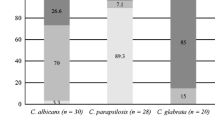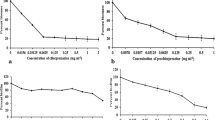Abstract
It is common knowledge that Candida albicans are one of the main sources of fungal infections which may lead to inflammation or even threaten life. Until now, fungal infection treatment has been considered as a challenging task due to several problems associated with their application like toxicity, drug interactions, and resistance. This paper outlines a new approach to develop effective agents against Candida albicans biofilms. The impact of borneols and sulfur-containing terpenoids of bornane series on the in vitro formation and growth of clinical strain of C. albicans in biofilms has been studied and compared with modern antimycotics. As a result, thioterpenoid 4 minimum inhibitory concentrations for C. albicans strain plankton ranged from 100 to 200 μg/ml where biofilm growth inhibition occurred at the concentration of 200 μg/ml. It is generally accepted that fluconazole 7 is widely used in clinical practice but still not effective against biofilms of C. albicans fungi. Therefore, we believe that isoborneol 2 and thioterpenoids 3 and 4, as well as terbinafine 6, can be promising starting points for the development of new antifungal agents against the pathogenic activity of fungi including pathogens embedded in biofilms since they demonstrated an effective resistance against the formation of pseudomycelia.



Similar content being viewed by others
References
Hung, C., Kao, K., Wang, N., Hu, C., Hsieh, J., & Fu, Y. (2012). Invasive fungal infection among hematopoietic stem cell transplantation patients with mechanical ventilation in the intensive care unit. BMC Infectious Diseases, 10, 1186–1471.
Pinner, R. W. (1996). Trends in infectious diseases mortality in the United States. Journal of the American Medical Association, 275(3), 189–193.
Brown, G. D., Denning, D. W., & Gow, N. A. (2012). Hidden killers: human fungal infections. Science Translational Medicine, 19(4), 165rv13.
Murray, C. J., Rosenfeld, L. C., & Lim, S. S. (2012). Global malaria mortality between 1980 and 2010: a systematic analysis. Lancet, 4(379), 413–431.
Morio, F. (2010). Screening for amino acid substitutions in the Candida albicans Erg11 protein of azole-susceptible and azole-resistant clinical isolates: new substitutions and a review of the literature. Diagnostic Microbiology and Infectious Disease, 66(4), 373–384.
Xiang, M. J., Liu, J. Y., Wang, S., & Shi, C. (2013). Erg11 mutations associated with azole resistance in clinical isolates of Candida albicans. FEMS Yeast Research, 13(4), 386–393.
Nikitina, L. E., Startseva, V. A., Vakulenko, I. A., Khismatulina, I. M., Lisovskaya, S. A., Glushko, N. P., & Fassakhov, R. S. (2009). Synthesis and antifungal activity of compounds of the pinane series. Pharmaceutical Chemistry Journal, 43(5), 251–254.
Gavrilov, V. V., Startseva, V. A., Nikitina, L. E., Lodochnikova, O. A., Gnezdilov, O. I., Lisovskaya, S. A., Glushko, N. I., & Klimovitskii, E. N. (2010). Synthesis and antifungal activity of sulfides, sulfoxides, and sulfones based on (1S)-(-)-β-pinene. Pharmaceutical Chemistry Journal, 44(3), 126–129.
Nikitina, L. E., Startseva, V. A., Dorofeeva, L. Y., Artemova, N. P., Kuznetsov, I. V., Lisovskaya, S. A., & Glushko, N. P. (2010). Antifungal activity of bicyclic monoterpenoids and terpenesulfides. Chemistry of Natural Compounds, 46(1), 28–32.
Nikitina, L. E., Startseva, V. A., Artemova, N. P., Dorofeeva, L. Y., Kuznetsov, I. V., Lisovskaya, S. A., Glushko, N. P., & Kutyreva, M. P. (2012). Synthesis and antifungal activity of monoterpenoids of the carane series. Pharmaceutical Chemistry Journal, 45(11), 664–667.
Nikitina, L. E., Artemova, N. P., Startseva, V. A., Fedyunina, I. V., & Klochkov, V. V. (2017). Biological activity of S-containing monoterpenoids. Chemistry of Natural Compounds, 53(5), 811–819.
European Committee for Antimicrobial Susceptibility Testing (EUCAST) of the European Society of Clinical Microbiology and Infectious Dieases (ESCMID). EUCAST Definitive Document E.DEF 1.2. (2000). Determination of minimum inhibitory concentrations (MICs) of antibacterial agents by agar dilution. Clinical Microbiology and Infection, 6(9), 503–508.
Ishmuratov, G. Y., Yakovleva, M. P., Tukhvatshin, V. S., Talipov, R. F., Nikitina, L. E., Artemova, N. P., Startseva, V. A., & Tolstikov, G. A. (2014). Sulfurcontaining derivatives of mono- and bicyclic natural monoterpenoids. Chemistry of Natural Compounds, 50(1), 22–47.
Leclercq, R., Canto’n, R., Brown, D. F. J., Giske, C. G., Heisig, P., MacGowan, A. P., Mouton, J. W., Nordmann, P., Rodloff, A. C., Rossolini, G. M., Soussy, C.-J., Steinbakk, M., Winstanley, T. G., & Kahlmeter, G. (2013). EUCAST expert rules in antimicrobial susceptibility testing. Clinical Microbiology and Infection, 19(2), 141–160.
Ramage, G., Walle, K. V., Wickes, B. L., & Lopez-Ribot, J. L. (2001). Standartized method for in vitro antifungal susceptibility testing of Candida albicans biofilms. Antimicrobial Agents and Chemotherapy, 45, 2475–2479.
Herigstad, B., Hamilton, M., & Heersink, J. (2001). How to optimize the drop plate method for enumerating bacteria. Journal of Microbiological Methods, 44(2), 121–129.
Peeters, E., Nelis, H. J., & Coenye, T. (2008). Comparison of multiple methods for quantification of microbial biofilms grown in microtiter plates. Journal of Microbiological Methods, 72(2), 157–165.
Kumari, V., Banerjee, T., Kumar, P., Pandey, S., & Tilak, R. (2013). Emergence of nonalbicans Candida among candidal vulvovaginitis cases and study of their potential virulence factors, from a tertiary care center, North India. Indian Journal of Pathology & Microbiology, 56, 144–147.
Author information
Authors and Affiliations
Corresponding author
Ethics declarations
Conflict of Interest
None.
Research Involving Humans and Animals Statement
None.
Informed Consent
None.
Funding Statement
None.
Additional information
Publisher’s Note
Springer Nature remains neutral with regard to jurisdictional claims in published maps and institutional affiliations.
Rights and permissions
About this article
Cite this article
Nikitina, L.E., Lisovskaya, S.А., Startseva, V.A. et al. Development of Novel Effective Agents Against Candida albicans Biofilms. BioNanoSci. 9, 539–544 (2019). https://doi.org/10.1007/s12668-019-00648-6
Published:
Issue Date:
DOI: https://doi.org/10.1007/s12668-019-00648-6




